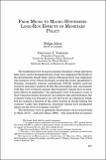Mostrar el registro sencillo del ítem
From micro to macro hysteresis: long-run effects of monetary policy
| dc.contributor.author | Alves, Felipe | |
| dc.contributor.author | Violante, Giovanni L. | |
| dc.date.accessioned | 2024-12-05T16:36:31Z | |
| dc.date.available | 2024-12-05T16:36:31Z | |
| dc.date.issued | 2024 | |
| dc.identifier.isbn | 9789567421749 | |
| dc.identifier.isbn | 9789567421732 (digital) | |
| dc.identifier.issn | 0717-6686 (Series on Central Banking, Analysis, and Economic Policies) | |
| dc.identifier.uri | https://hdl.handle.net/20.500.12580/8024 | |
| dc.description | The traditional view of macroeconomic dynamics is that aggregate time series can be decomposed into a long-run component (the trend, or the deterministic steady state) and an orthogonal short-run component (the business cycle) which fluctuates around the trend. Quantitative dynamic stochastic general equilibrium (DSGE) models used for research and policy analysis fit into this escription and, consistently with this view, routinely assume that transitory shocks have no longterm effects on aggregates.1 An alternative view of business cycles is that of macroeconomic hysteresis. According to this interpretation, the economy’s long-run dynamics are not driven by an exogenous trend, but are instead a function of the entire history of shocks hitting the economy. Under this hypothesis, transitory shocks have permanent effects on the level of economic activity. | es |
| dc.description.abstract | The traditional view of macroeconomic dynamics is that aggregate time series can be decomposed into a long-run component (the trend, or the deterministic steady state) and an orthogonal short-run component (the business cycle) which fluctuates around the trend. Quantitative dynamic stochastic general equilibrium (DSGE) models used for research and policy analysis fit into this escription and, consistently with this view, routinely assume that transitory shocks have no longterm effects on aggregates.1 An alternative view of business cycles is that of macroeconomic hysteresis. According to this interpretation, the economy’s long-run dynamics are not driven by an exogenous trend, but are instead a function of the entire history of shocks hitting the economy. Under this hypothesis, transitory shocks have permanent effects on the level of economic activity. | es |
| dc.format | ||
| dc.format.extent | Sección o Parte de un Documento | |
| dc.format.medium | p. 227-273 | |
| dc.language.iso | en | es |
| dc.publisher | Banco Central de Chile | es |
| dc.relation.ispartofseries | Series on Central Banking Analysis and Economic Policies; no. 30 | |
| dc.rights | Attribution-NonCommercial-NoDerivs 3.0 Chile | * |
| dc.rights.uri | http://creativecommons.org/licenses/by-nc-nd/3.0/cl/ | * |
| dc.subject | POLÍTICA MONETARIA | es |
| dc.title | From micro to macro hysteresis: long-run effects of monetary policy | es |
| dc.type.doc | Artículo |


